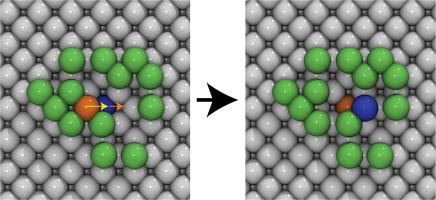当前位置:
X-MOL 学术
›
Comp. Mater. Sci.
›
论文详情
Our official English website, www.x-mol.net, welcomes your feedback! (Note: you will need to create a separate account there.)
Decision tree driven construction of rate constant models: Identifying the “top-N” environment atoms that influence surface diffusion barriers in Ag, Cu, Ni, Pd and Pt
Computational Materials Science ( IF 3.3 ) Pub Date : 2020-11-01 , DOI: 10.1016/j.commatsci.2020.109876 Sandip Sawarkar , Abhijit Chatterjee
Computational Materials Science ( IF 3.3 ) Pub Date : 2020-11-01 , DOI: 10.1016/j.commatsci.2020.109876 Sandip Sawarkar , Abhijit Chatterjee

|
Abstract The local chemical environment is known to influence the rate constants of thermally activated atomic-scale processes in materials. In situations where rate constants vary over several orders of magnitude, dynamical materials simulations often require accurate rate constant models that can rapidly predict the rate for vast number of environments. Deriving rate constant models by fitting to a database of barriers can be particularly challenging when several environment atoms are believed to affect the rate. Previously, artificial neural networks (ANN) and cluster expansion models (CEM) have been employed as rate constant models. We demonstrate that a decision tree (DT) can complement training of such models by providing useful inputs. DTs can be used to (i) determine the relevant chemical environment, (ii) estimate the accuracy expected from CEM/ANN, (iii) identify cluster sizes required in CEM or size of the input layer in ANN so that the CEM/ANN model can be trained in a single step, and (iv) determine the minimum amount of data required for accurate training. Using this strategy, we construct for the first time CEM and ANN models for the exchange move (surface diffusion of metal on metal) that are both compact and accurate. The use of DT has enabled inclusion of large clusters, as big as 11 atom clusters in the CEM. Our strategy paves way for coupling DT and CEM/ANN for building computationally inexpensive rate constant models.
中文翻译:

决策树驱动的速率常数模型构建:识别影响 Ag、Cu、Ni、Pd 和 Pt 表面扩散势垒的“top-N”环境原子
摘要 已知局部化学环境会影响材料中热激活原子级过程的速率常数。在速率常数在几个数量级上变化的情况下,动态材料模拟通常需要准确的速率常数模型,以快速预测大量环境的速率。当多个环境原子被认为会影响速率时,通过拟合势垒数据库来推导速率常数模型可能特别具有挑战性。以前,人工神经网络 (ANN) 和集群扩展模型 (CEM) 已被用作速率常数模型。我们证明决策树 (DT) 可以通过提供有用的输入来补充此类模型的训练。DT 可用于 (i) 确定相关化学环境,(ii) 估计 CEM/ANN 的预期精度,(iii) 确定 CEM 中所需的集群大小或 ANN 中输入层的大小,以便可以在一个步骤中训练 CEM/ANN 模型,以及 (iv) 确定准确训练所需的最少数据量。使用这种策略,我们首次构建了既紧凑又准确的交换移动(金属在金属上的表面扩散)的 CEM 和 ANN 模型。DT 的使用使得包含大簇成为可能,CEM 中有 11 个原子簇。我们的策略为耦合 DT 和 CEM/ANN 以构建计算成本低廉的速率常数模型铺平了道路。(iv) 确定准确训练所需的最少数据量。使用这种策略,我们首次构建了既紧凑又准确的交换移动(金属在金属上的表面扩散)的 CEM 和 ANN 模型。DT 的使用使得包含大簇成为可能,CEM 中有 11 个原子簇。我们的策略为耦合 DT 和 CEM/ANN 以构建计算成本低廉的速率常数模型铺平了道路。(iv) 确定准确训练所需的最少数据量。使用这种策略,我们首次构建了既紧凑又准确的交换移动(金属在金属上的表面扩散)的 CEM 和 ANN 模型。DT 的使用使得包含大簇成为可能,CEM 中有 11 个原子簇。我们的策略为耦合 DT 和 CEM/ANN 以构建计算成本低廉的速率常数模型铺平了道路。
更新日期:2020-11-01
中文翻译:

决策树驱动的速率常数模型构建:识别影响 Ag、Cu、Ni、Pd 和 Pt 表面扩散势垒的“top-N”环境原子
摘要 已知局部化学环境会影响材料中热激活原子级过程的速率常数。在速率常数在几个数量级上变化的情况下,动态材料模拟通常需要准确的速率常数模型,以快速预测大量环境的速率。当多个环境原子被认为会影响速率时,通过拟合势垒数据库来推导速率常数模型可能特别具有挑战性。以前,人工神经网络 (ANN) 和集群扩展模型 (CEM) 已被用作速率常数模型。我们证明决策树 (DT) 可以通过提供有用的输入来补充此类模型的训练。DT 可用于 (i) 确定相关化学环境,(ii) 估计 CEM/ANN 的预期精度,(iii) 确定 CEM 中所需的集群大小或 ANN 中输入层的大小,以便可以在一个步骤中训练 CEM/ANN 模型,以及 (iv) 确定准确训练所需的最少数据量。使用这种策略,我们首次构建了既紧凑又准确的交换移动(金属在金属上的表面扩散)的 CEM 和 ANN 模型。DT 的使用使得包含大簇成为可能,CEM 中有 11 个原子簇。我们的策略为耦合 DT 和 CEM/ANN 以构建计算成本低廉的速率常数模型铺平了道路。(iv) 确定准确训练所需的最少数据量。使用这种策略,我们首次构建了既紧凑又准确的交换移动(金属在金属上的表面扩散)的 CEM 和 ANN 模型。DT 的使用使得包含大簇成为可能,CEM 中有 11 个原子簇。我们的策略为耦合 DT 和 CEM/ANN 以构建计算成本低廉的速率常数模型铺平了道路。(iv) 确定准确训练所需的最少数据量。使用这种策略,我们首次构建了既紧凑又准确的交换移动(金属在金属上的表面扩散)的 CEM 和 ANN 模型。DT 的使用使得包含大簇成为可能,CEM 中有 11 个原子簇。我们的策略为耦合 DT 和 CEM/ANN 以构建计算成本低廉的速率常数模型铺平了道路。



























 京公网安备 11010802027423号
京公网安备 11010802027423号